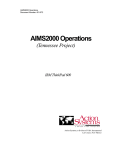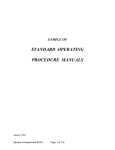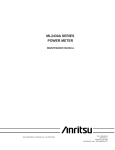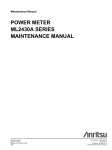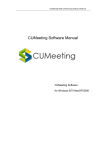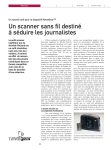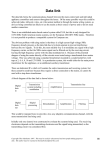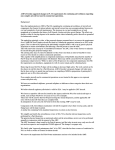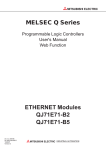Download Xircom Action Systems 1500 User's Manual
Transcript
GSA Operations Document Number: 401-364 GSA Operations Model 1500 Action Systems, a division of V&A Incorporated Las Cruces, New Mexico GSA Operations Document Number: 401-364 GSA Operations Action Systems, a division of V&A Incorporated 480 North 17th Street Las Cruces, New Mexico 88005 (505) 526-6606 http://www.goaction.com January 13, 2000 The Action Systems’ “A” case concept and design is protected under the following United States patents: 5,212,628 , 5,226,540 , 5,442,512 , 5,590,022 . Copyright © 1998 Action Systems, a division of V&A Incorporated. No part of this manual may be stored in a retrieval system, transmitted, or reproduced in any way, including but not limited to photocopy, photograph, magnetic or other record, without the prior agreement and written permission of Action Systems. WRITTEN BY: ________________________________ Sean Gilliam (Engineering) TESTED BY: _________________________________ Yadira Cano (Integration and Testing) APPROVED BY: ________________________________ Jim Mansfield (Quality Assurance) 2 GSA Operations Document Number: 401-364 Table of Contents Preface..................................................................................................................................... 7 Component Overview ........................................................................................................... 8 Case Power Sources............................................................................................................. 9 External A/C Power ..............................................................................................10 External D/C Power ..............................................................................................11 Internal Battery System ........................................................................................12 D/C-To-A/C Power Inverter ..................................................................................12 Computer Power Sources.................................................................................................. 13 Case Supplied Power...........................................................................................13 Computer Battery .................................................................................................13 Computer A/C Adapter .........................................................................................13 Power Management............................................................................................................. 14 Controls and Indicators...................................................................................................... 15 External Power Light ............................................................................................15 Case Battery Status Light.....................................................................................15 STORE / POWER Switch.....................................................................................16 CPU Switch ..........................................................................................................16 CAMERA / COM 1 Switch ....................................................................................17 NONSECURE/STU Switch...................................................................................17 Turning on the System ....................................................................................................... 18 To power up the case...........................................................................................18 To power up the computer ...................................................................................18 Operating System................................................................................................................ 19 Logging In.............................................................................................................19 Shutting Down ......................................................................................................20 Removing PCMCIA Cards....................................................................................21 Software................................................................................................................................. 22 Creating a Document ...........................................................................................22 3 GSA Operations Document Number: 401-364 Retrieving an Existing Document .........................................................................23 Printing .................................................................................................................................. 24 Printer Setup.........................................................................................................24 Printing a Document.............................................................................................26 Imaging .................................................................................................................................. 27 Scanning an Image or a Text Document using the PageScan Scanner..............27 Non-Secure Communication Connections ..................................................................... 31 Connecting to a Phone Line for Non-Secure Connections ..................................31 Connecting to a Local Area Network (LAN) to Access the Internet .....................32 Connecting to the Internet over a Phone Line......................................................33 Non-Secure Data: Sending and Receiving...................................................................... 36 Sending Non-Secure Data ...................................................................................36 Receiving Non-Secure Data.................................................................................38 Non-Secure Faxes: Sending and Receiving ................................................................... 40 Sending a Non-Secure FAX .................................................................................40 Receiving a Non-Secure FAX ..............................................................................43 Troubleshooting................................................................................................................... 44 Case and Power System......................................................................................44 Computer..............................................................................................................45 Printer ...................................................................................................................46 Scanner ................................................................................................................47 Modem/FAX Cards ...............................................................................................48 PCMCIA Cards .....................................................................................................49 Disk Recovery Procedures ................................................................................................ 50 Appendix A: Panel Color Coding...................................................................................... 51 Appendix B: Secure Switch Matrix................................................................................... 52 Appendix E: Components.................................................................................................. 53 Warranty Information .......................................................................................................... 56 4 GSA Operations Document Number: 401-364 Table of Figures Figure 1 "A" Case .........................................................................................................8 Figure 2 "B" Case .........................................................................................................8 Figure 3 External A/C Power Input .............................................................................10 Figure 4 External D/C Power Input .............................................................................11 Figure 5 Power Inverter Panel ....................................................................................12 Figure 6 Controls and Indicators.................................................................................15 Figure 7 External COM ...............................................................................................17 Figure 8 Power Switch and Indicator ..........................................................................18 Figure 9 Logging in .....................................................................................................19 Figure 10 Shut Down Windows ..................................................................................20 Figure 11 Creating a New Document. ........................................................................22 Figure 12 Retrieving an Existing Document ...............................................................23 Figure 13 Printer connection.......................................................................................24 Figure 14 Printer cover ...............................................................................................24 Figure 15 Printer cartridge ..........................................................................................25 Figure 16 PageScan Scanner.....................................................................................28 Figure 17 Foto Touch..................................................................................................29 Figure 18 OCR Scan...................................................................................................30 Figure 19 Telephone Connection ...............................................................................31 Figure 20 LAN/Modem Connections...........................................................................31 Figure 21 Welcome Message .....................................................................................33 Figure 22 New Connection Setup...............................................................................34 Figure 23 Phone Number ...........................................................................................35 Figure 24 ProComm Plus Indicators...........................................................................37 Figure 25 ProComm Send File ...................................................................................38 Figure 26 ProComm Receive Screen .........................................................................39 Figure 27 Selecting the ProComm Plus Printer ..........................................................40 5 GSA Operations Document Number: 401-364 Figure 28 ProComm Plus – Send Fax ........................................................................41 Figure 29 ProComm Plus Fax Status .........................................................................42 6 GSA Operations Document Number: 401-364 Preface The GSA Unit is an integrated computer system in a ruggedized transportable carrying case. It contains a comprehensive power storage and management system, a laptop computer (with its own power management capabilities), a printer, and a page scanner. Software is included to operate and integrate all of this equipment as well as several models of digital camera. This document describes the features of the GSA Unit and addresses the operation, troubleshooting, and correction of commonly encountered situations. Because each of the installed software packages contains many options for individual situations, specific technical questions should be referred to the included technical manuals. 7 GSA Operations Document Number: 401-364 Component Overview The GSA Unit consists of two cases: • The “A” case (Figure 1) may contain the laptop computer, the printer, the scanner, the camera, the power inverter, a STU-III and internally mounted batteries and power management systems. This case contains the most frequently used components of the GSA UNIT and will probably be the most used. Figure 1 "A" Case • The “B” case (Figure 2) is a soft case that contains the various telephone and power adapters, and a small tool kit. The A/C adapters for the various components of the system (i.e. computer, printer, etc.) may be carried in this case. This case should be deployed with the GSA Unit. Figure 2 "B" Case 8 GSA Operations Document Number: 401-364 Case Power Sources The GSA Unit can operate from a variety of power sources: external A/C power, external D/C power, and from internal batteries. When connecting to or disconnecting from an external power source, you may hear a click from inside the case. This is caused by relays within the unit and is normal. CAUTION: THE EQUIPMENT COVERS INSIDE THE GSA UNIT SHOULD NOT BE OPENED! Hazardous voltages may be present at any time and there are no field serviceable components inside. CAUTION: Most power sources and components come with a panel or label stating their power ranges. If these ranges are exceeded, then there is a very strong potential to cause irreparable damage to the case and/or component causing it to malfunction or not to work at all. Therefore do not push these sources beyond their designated power ranges. 9 GSA Operations Document Number: 401-364 External A/C Power The Alternating Current (A/C) connection to the GSA Unit accepts input voltages from 90 to 250 VAC at 50 to 60 Hz, as stated on the External A/C Power panel. Depending on the components in use, the state of the various batteries in the system, and the current operating conditions, the system will draw up to one ampere from the source. The system has circuitry to ensure overloads do not cause damage to the GSA Unit or to the installed components. The system also contains protection against heat by monitoring the temperature inside the case to ensure it does not exceed 170 degrees Fahrenheit. NOTE: When the case exceeds 170 degrees Fahrenheit, the case will shut itself down. After the case has cooled down, the case will be able to be turned back on. This downtime depends on how hot the case was when it finally turned itself off. A/C electrical power is supplied to the GSA Unit through a standard, three-wire power plug connected at the back panel of the case (as shown in Figure 3). Connect the other end of the power cord to a three-prong power source. Using appropriate adapters, the GSA Unit may be connected to a wide variety of sources. Since it will accept a wide variation in input voltages and frequency, as described above, the GSA Unit can be safely connected to standard A/C power sources throughout most of the world. Nonetheless, precautions must be taken to ensure the power connections are correct. In particular, the GSA Unit is not certified for direct connection to US military aircraft since power is usually generated at 400 Hz unless indicated on Input Power Panel. Figure 3 External A/C Power Input The GSA Unit contains circuitry that will automatically reset after an overload, but if the system fails and does not come back up after approximately 10 minutes, the unit must be considered in a non-recoverable condition and should be returned to the factory for repair. 10 GSA Operations Document Number: 401-364 External D/C Power The Direct Current (D/C) Power Supply connector is the small, translucent plastic, arrow shaped connector on the back panel below the A/C power input (as shown in Figure 4). The acceptable input voltages are 10 to 14 VDC. Nonetheless, precautions must be taken to ensure the power connections are correct. NOTE: If the voltages stated on the panel are exceeded, then there is the potential to harm the components connected to the case, especially the laptop. Figure 4 External D/C Power Input 11 GSA Operations Document Number: 401-364 Internal Battery System Using internal batteries, no external power connections are required. When the GSA Unit is connected to an external power source, the internal batteries will automatically charge with power on or off. Fully discharged batteries may require five to ten minutes of charge prior to laptop and peripheral operation, if the case is being used at the same time that it is charging (connected to external power). To fully recharge the drained batteries, then they require 8 to 10 hours. NOTE: All batteries have a limited life expectancy. Depending upon patterns of use and charging of the case batteries, the GSA unit should be sent back to the manufacturer every 18 to 36 months for replacement. D/C-To-A/C Power Inverter The D/C-to-A/C power inverter connects to the case through the GSA Unit power inverter connector, which is colored green (shown in Figure 5). The D/C plug connects to the D/C power supply connector labeled Inverter PWR on the green panel. The range of D/C input to the inverter is between 10 to 15 volts DC at 5 amperes. The inverter can accept any standard, three-prong plug. The output generated by the inverter is 115 volts A/C. NOTE: The maximum A/C wattage the inverter can safely supply is 30 Watts. Any more than this has the potential to damage the inverter. Don’t hook your hairdryer, shaver, or any other high wattage draw items to the inverter! Figure 5 Power Inverter Panel 12 GSA Operations Document Number: 401-364 Computer Power Sources Case Supplied Power Since the GSA Unit is a fully integrated system, this is the preferred operating method. To operate in this mode, dock the computer, insert the power cable on the docking bar to the computer’s power input, and flip the CPU switch to the ON position. Computer Battery If you do not wish to power the computer through the case’s power supply, then you can use the computer’s internal battery to power it. To operate in this mode, either undock the computer or with the computer docked, flip the CPU switch to the OFF position. This switches the computer to battery operated mode. To recharge the computer batteries, dock the computer back into the GSA Unit with the CPU switch in the ON position or plug the computer into a suitable A/C power source with the supplied A/C power adapter. For the fastest recharge, the computer must be powered off. Computer A/C Adapter The computer normally gets its power from either the GSA Unit case or from its internal batteries. A third way to power the computer is to plug it into an A/C power source, e.g., a wall outlet. For this purpose, an A/C power adapter specifically designed just for the computer has been included with the GSA Unit. 13 GSA Operations Document Number: 401-364 Power Management Because the GSA Unit is a sophisticated system with multiple potential power sources and several battery-powered components, optimal Power Management requires operator actions. When external power, either A/C or D/C, is available, that should be the preferred operating mode since it will generally provide the longest uninterrupted operation. One of the best techniques when external power is not available is to take advantage of the power management features of the laptop computer. Place the CPU switch in the off position. This cuts off case battery power to the laptop forcing it to run on its own battery, while still providing power to the peripheral components. When the batteries in the computer become low with use, the CPU switch can be placed back in the on position until the computer batteries have been restored. After a couple of hours on case battery power, the GSA Unit internal batteries are no longer able to fully charge the computer batteries and/or provide power to the peripherals. At this point, the GSA Unit should be connected to external power or data should be saved to disk and preparations made to power down the system. The GSA Unit peripherals can consume quite a bit of power, even when just idling. Therefore, if you anticipate operating for an extended period on the batteries, turn off any peripherals you are not using. 14 GSA Operations Document Number: 401-364 Controls and Indicators The GSA Unit control panel holds two lights and four operator accessible switches, all with internal lights (see Figure 6). Figure 6 Controls and Indicators External Power Light This light, labeled EXT PWR and located between the STORE/POWER switch and the CPU switch, is illuminated red whenever the GSA Unit is connected to external power. The case batteries will be recharging when this light is on. Case Battery Status Light This light, labeled CASE BATTERY and located between the CAMERA/COM 1 switch and the NONSECURE/STU switch, is green when there is plenty of power remaining in the case's internal batteries and red when the power in the batteries is low (an alarm will also sound). NOTE: When the alarm sounds, immediately start to shut the system down. There is at least five minutes until the case's power is unable to support the system. This should be enough time to save all unsaved work before the system shuts down. However the laptop will continue to function normally, depending upon its battery’s charge capacity. NOTE: Switching the power switch to STORE can turn off the alarm. This also stops all components not powered by their own power supply. 15 GSA Operations Document Number: 401-364 STORE / POWER Switch In the STORE position, the computer and peripherals are disconnected from A/C and D/C power. This should be the position of the switch when the unit is to be stored for more than one day. NOTE: Since the internal GSA Unit case batteries and battery charging system are always connected to external power through the STORE or POWER position, during long periods of storage the GSA Unit batteries can be periodically “topped off” by applying power to the GSA Unit for a few hours. In the POWER position, the GSA Unit peripherals (except the laptop) are powered by the case. The computer needs both the POWER and CPU switches to be in the ON position to operate. The normal operation should have the POWER and CPU switches on (illuminated) with the NONSECURE/STU switch in the NONSECURE position. CPU Switch With the CPU power plug properly inserted and the CPU and POWER switches on, the GSA Unit case provides power to the laptop computer and the light internal to the switch is illuminated. With the CPU switch in the off position, the laptop computer operates on its internal batteries. 16 GSA Operations Document Number: 401-364 CAMERA / COM 1 Switch NOTE: In either position, the CAMERA/COM1 switch only works when the NONSECURE/STU switch is in the NONSECURE position. When the NONSECURE/STU switch is in the STU position, both COM1 and CAMERA ports are disabled. In the CAMERA position, the serial port of the computer is connected to the orange serial port on the inside panel of the case. In the COM 1 position, the serial port of the computer is connected to the 9-pin COM 1 connector (DB9) on the back panel of the case (see Figure 7). Figure 7 External COM NONSECURE/STU Switch When the NONSECURE/STU switch is in the STU position (the LED in the switch lights up red), all data passes through the STU-III. In this position, the STU-III can be used in all modes: Non-Secure Voice, Secure Voice, and Secure Data. When the NONSECURE/STU switch is in the NONSECURE position (the LED in the switch is not lit up), all non-secure communication connections (LAN and COM1) are connected. Data sent or received in this mode will be only in Non-Secure mode. 17 GSA Operations Document Number: 401-364 Turning on the System CAUTION: Before beginning a computer session, running a full Disk Recovery is highly recommended to reset the entire system, especially if this is the first session of a new series of operating sessions (see page 50). To power up the case • Locate the switch labeled STORE/POWER. • Position the switch to the POWER position. Power will now be provided to all devices in the case except the computer. To power up the computer • Ensure the STORE/POWER switch is in the POWER position and then turn on the switch labeled CPU. • Press the display release on the front of the computer and lift the display panel. • Press and hold the Power Switch on the side of the laptop until the Power Indicator light illuminates (as shown in Figure 8). Figure 8 Power Switch and Indicator 18 GSA Operations Document Number: 401-364 Operating System Logging In When Windows98 first starts up, a login dialog will appear. If the computer is hooked up to a network, then the first login dialog in (Figure 9) will appear. If not, then the second dialog will appear. Either way, enter your User name and Password. Click OK. After this, Windows will finish the boot process and you can begin work on the computer. Figure 9 Logging in 19 GSA Operations Document Number: 401-364 Shutting Down NOTE: Before any shutdown procedure, be sure to MOVE all data files off of the hard drive and onto removable storage media. The hard drive should be devoid of ANY classified data. Then do a DISK RECOVERY with either the CD for the 780 laptop or the CD and floppy for the 740. This will reset the entire system and "erase” any data on the hard drive and reset the system. NOTE: It is very important that you let Windows shut down your computer before you turn the power off. Otherwise, Windows will start to exhibit anomalous behavior. Follow these steps to shut down the computer: • Click Start and then Shut Down. Windows will display a box similar to that shown in Figure 10. Figure 10 Shut Down Windows 20 • Make sure the circle for Shut down has a dot. If it does not, click on the empty circle and one will appear. • Click the OK button and Windows will shut down the computer. GSA Operations Document Number: 401-364 Removing PCMCIA Cards To remove PCMCIA cards from the computer: CAUTION: There exists a potential to damage a PCMCIA card if you do not first stop the card before removing it. • Left click on the PCMCIA card icon located on the lower right hand side of the computer screen (near the clock). • A list of cards that are currently inserted in the computer will appear. • Select the one you want to remove and click on it. • Wait for a confirmation notice, then remove it. 21 GSA Operations Document Number: 401-364 Software Creating a Document To create a document: • From the Desktop, double-click on the Microsoft Office folder. This will open a window similar to that in (Figure 11). Figure 11 Creating a New Document. • Double-click on one of the icons as appropriate for the document to be created. For example, to create a new spreadsheet, double-click on the Microsoft Excel icon. This will start the application and load an empty document ready for you to start working. • When you are finished editing the document, be sure to SAVE it to disk so that it will be available for editing during a future session. This is achieved by clicking on File -> Save. NOTE: By default, Office 97 will save your documents in the My Documents folder unless you specify a different location. NOTE: Before any shutdown procedure, be sure to MOVE all data files off of the hard drive and onto removable storage media. The hard drive should be devoid of ANY classified data. Then do a DISK RECOVERY with either the CD for the 780 laptop or the CD and floppy for the 740. This will reset the entire system and "erase” any data on the hard drive and reset the system. 22 GSA Operations Document Number: 401-364 Retrieving an Existing Document To retrieve an existing document: NOTE: Unless specified otherwise, during a SAVE or SAVE AS operation of a file, the system defaults to saving all data files in the My Documents folder. • From the Desktop, double-click on the My Documents folder or whatever folder you specified, to open a window similar to that in (Figure 12). Figure 12 Retrieving an Existing Document • Double-click on the document you want to edit. Windows will automatically open the document using the application associated with that document. 23 GSA Operations Document Number: 401-364 Printing Printer Setup To print from the computer, first setup the printer following these instructions: • If the computer is not connected to the docking tray, then connect it. • Connect the printer’s power and signal cable (wrapped together in white) as shown in Figure 13. Figure 13 Printer connection • Turn the printer’s power on. • Open the printer’s cover as shown in Figure 14. Figure 14 Printer cover 24 GSA Operations Document Number: 401-364 • If the cartridge is centered and empty (a beeping should be heard warning that no ink cartridge is installed), insert an ink cartridge, close the cover, and press the cartridge button to reset the printer. Figure 15 Printer cartridge • If no warning beeps are heard and the carriage is stationed on the right side of the printer, then it should be ready to print. • If you need to change an ink cartridge, press the cartridge button on the printer to center the carriage. Open the lid, exchange a new ink cartridge for the old one, close the lid, and again press the cartridge button to reset the printer. • Once the printer finishes testing the cartridge, the printer is ready to be used. NOTE: If printing color output, be sure the color ink cartridge is installed If printing large quantities (more than 15) of black print output (no color), change the ink cartridge carriage to the large black ink carriage and insert a large black ink cartridge. 25 GSA Operations Document Number: 401-364 Printing a Document To print a document: NOTE: All of the following actions will print the document to the default printer. If this is not what you want, then open the associated program (if not already open) and from the menu bar click on the File menu and select Print. This will bring up a dialog in which you can select the printer desired. 26 • Make sure the printer is connected (See the previous section on how to do this). • Turn the printer’s power on. • Now then you have the following two choices: • For an open document, click on the printer icon. • OR • From the folder in which you saved the file (the default all data files is the My Documents folder), right-click on the document and choose Print. GSA Operations Document Number: 401-364 Imaging Scanning an Image or a Text Document using the PageScan Scanner To scan a picture using the page scanner: CAUTION: The scanner is self-propelled. Do not force paper through the scanner and do not force the scanner across a page. Damage to the scanner may result. CAUTION: You must lift up a crawling scanner to stop it. Please do not let it fall off the table! NOTE: If there is more than one scanning program open, then you will not be able to scan. The solution to this problem is to close all scanning programs, then proceed with the following steps. • To attach the scanner to the base, orient the scanner so that the Logitech logo faces you. Align the vertical plastic guide pin on the right side with the end of the base that has a slot in which the guide pin will fit. Slide the right side with the pin down onto the base first, then press the left side down until it snaps into place. • To remove the scanner from the base, lift up on the left side (Logitech emblem facing you) of the scanner until it snaps out of place and then remove the base. • Make sure the PageScan Scanner is connected. If it is not, then connect the scanner cable to the connector located on the orange panel of the GSA Unit case. There is only one cable carrying both power and data. • Place the picture or text document to be scanned in either of the following positions: • With the scanner base attached, insert the document just into the feed rollers at the front of the scanner with the paper guides and stop. Do not push paper further. OR • With the scanner base detached, place the scanner section on top of the document (Do not push or pull the scanner. It will crawl over the document on its own). • The scanner application program will automatically open a window similar to that shown in Figure 16. If it does not open, double-click the Imaging folder located on the Desktop. From there double-click PageScan Control Center. 27 GSA Operations Document Number: 401-364 Figure 16 PageScan Scanner 28 GSA Operations Document Number: 401-364 To scan a picture: • Click on the Picture icon as shown in Figure 16. This brings up a window similar to that shown in Figure 17. Figure 17 Foto Touch • Select a Destination for the picture. • Click on the Scan Now button to begin scanning the picture. You will get the highest resolution scan using Black and White Picture as the Document Type. • From here, the program will exhibit one of two behaviors. These behaviors are as follows: • If you selected Save to a file (select after scanning) under Destination, the picture will be loaded into the Logitech Image Editor program. From there you can save the picture to a file (we recommend saving the file as a JPG type file for the greatest compatibility with other programs). You can now close Logitech Image Editor by clicking on File and then Exit. • If you selected a specific graphics program, the scanned picture will load up into that program. 29 GSA Operations Document Number: 401-364 To scan (OCR) a text document: • Click on the ABC icon as shown in Figure 16. This brings up a window similar to that in Figure 18. Figure 18 OCR Scan 30 • Select the Destination of the document. • Click on the Scan Now button to begin scanning the text. • From here, the program will exhibit one of two behaviors. These behaviors are as follows: • If you selected Save to a file (select after scanning) under Destination, a Save As window will come up for you to save the file under the desired destination (we recommend saving the document as a Word for Windows *.rtf file for the greatest compatibility with other programs). Type in the .rtf file extension in the file name box or the file will be lost. • If you selected a specific application program, the scanned document will load up into that program. GSA Operations Document Number: 401-364 Non-Secure Communication Connections Connecting to a Phone Line for Non-Secure Connections To connect the computer to a phone line: • Flip the NONSECURE/STU switch to the NONSECURE position. • Connect an RJ11 phone cable (a regular phone line) from the phone connection in the back of the case (shown in Figure 19) to the phone connection desired. Figure 19 Telephone Connection • Take the "Y" Phone Cable and connect the single plug end to the docking bar and insert the RJ11 plug into the RJ11 connector and the RJ45 plug into the RJ45 connector of the Xircom card (see Figure 20). • Insert the Xircom Card into the PCMCIA card slot of the computer (see Figure 20). Figure 20 LAN/Modem Connections 31 GSA Operations Document Number: 401-364 • The modem is ready for use. Connecting to a Local Area Network (LAN) to Access the Internet To connect the computer to a LAN: • Flip the NONSECURE/STU switch to the NONSECURE position. • Connect an RJ45 LAN cable (looks like the RJ11 phone line except a little thicker) from the LAN connection in the back of the case (shown in Figure 19) to the LAN connection desired. • Take the "Y" Phone Cable and connect the single plug end to the docking bar and insert the RJ45 plug into the RJ45 connection of the Xircom card (see Figure 20). • Insert the Xircom Card into the PCMCIA card slot of the computer. • Click on the Start button and go to the Run option. Type in the word winipcfg. • Click on Renew All and OK to get access to the LAN. NOTE: If the network connection is denied, then restart the computer with the LAN connection still in place. When Windows98 starts up, it will ask you for the network password. Once supplied, then the computer will be on the network. • 32 See the sections on non-secure communications for more details on how to use the modem. GSA Operations Document Number: 401-364 Connecting to the Internet over a Phone Line To connect the computer to the Internet over a phone line: • Connect the computer to a phone line as detailed in the subsection titled Connecting to a Phone Line on page 31. • Double-click the Comms folder located on the Desktop. • Double-click Dial-Up Networking. NOTE: The first time you do this a dialog box stating Welcome to Dial-Up Networking might appear. Any other time you access Dial-Up Networking, you will bypass this dialog box, in which case you would click Make New Connection to make a new connection. Click Next(see Figure 21). Figure 21 Welcome Message • In the first box, type a name for the connection type, i.e. GSA. • In the drop-down box, select the modem you want to use for the connection. • Click Next (see Figure 22). 33 GSA Operations Document Number: 401-364 Figure 22 New Connection Setup • Enter in a phone number to the machine you are trying to connect to. NOTE: If using an INMARSAT as your transmission source, you must insert 01# (13 commas) (country code, e.g. USA is 001) (phone number to be dialed) #. For example if you wanted to call someone in the USA, then you would dial 01#,,,,,,,,,,,,,0015555555555# . This allows the satellite connection to be made. 34 GSA Operations Document Number: 401-364 Figure 23 Phone Number • Click Next (see Figure 23). • Click Finish. • Using the right mouse button, click on the connection made. While holding down the mouse button, drag the icon onto the desktop. Let go of the button. • Click on Create Shortcut. • This will put a shortcut on the Desktop to the connection. • Double-click on the shortcut. A Connect To window will appear with the information provided. • Click Connect. This will start the call and make the connection. 35 GSA Operations Document Number: 401-364 Non-Secure Data: Sending and Receiving CAUTION: When in this mode, only Non-Secure data can be transmitted. Sending Non-Secure Data To transfer non-secure data using ProComm and the PCMCIA Modem: 36 • Insert the Xircom PCMCIA card as outlined in the Non-Secure Communication Connections section on Page 31. • Flip the NONSECURE/STU switch to the NONSECURE position. • Ensure that the receiving party has ProComm Plus Data Terminal open and ready to receive the data. • Click on the Comms folder on the Desktop. • Double click on ProComm Data Terminal. • Make sure that the third box in the ProComm Data Terminal status line reads Modem of Xircom 10-100+56. If it does not, click on it and select Modem of Xircom 10-100+56 from the list. • Click on CmdMode (located at the bottom right of the ProComm screen). A message will appear stating “This modem is no longer accessible to other applications.” Type ATDT and the phone number with no spaces (i.e. ATDT5555555). Press <ENTER>. GSA Operations Document Number: 401-364 • There are three indicators in ProComm Plus that let you know you are connected. They are the phone icon on the toolbar will be off the hook, the cd and cts lights will be red, and the word Connected will appear at the lower right. See Figure 24. Figure 24 ProComm Plus Indicators 37 GSA Operations Document Number: 401-364 • Once the connection is established, click on the send folder (this is the folder with the arrow pointing up and out of the folder). This will open the Send File window as shown in Figure 25. Figure 25 ProComm Send File • To start the transmission, click on the file to be transferred and click OK. • When the transmission is complete, exit ProComm by clicking on File and then Exit. Receiving Non-Secure Data To receive non-secure data using ProComm and the Xircom card: 38 • Insert the Xircom PCMCIA card as outlined in the Non-Secure Communication Connections section on page 31. • Flip the NONSECURE/STU switch to the NONSECURE position. • Click on the Comms folder on the Desktop. • Double click on ProComm Data Terminal. • Make sure that the third box in the ProComm Data Terminal status line reads Modem of Xircom 10-100+56. If it does not, click on it and select Modem of Xircom 10-100+56 from the list. GSA Operations Document Number: 401-364 • There are two ways to answer a data call: • • To automatically answer incoming calls, set the Xircom to answer data calls under the Options->System Options->Modem Connection. • To manually answer incoming calls, click on CmdMode (located at the bottom left of the ProComm screen). A message will appear stating “This modem is no longer accessible to other applications.” Type ATA when you see RING on the screen. Once the connection is established, GSA Unit will automatically receive the data and open the Receive window (see Figure 26). All files received are then put in the C:\My Documents\Data Download folder which can be reached by double-clicking on the My Documents folder located on the Desktop. Figure 26 ProComm Receive Screen 39 GSA Operations Document Number: 401-364 Non-Secure Faxes: Sending and Receiving CAUTION: When in this mode, only Non-Secure data can be transmitted. Sending a Non-Secure FAX To send a non-secure FAX: • Insert the Xircom PCMCIA card as outlined in the Non-Secure Communication Connections section on page 31. • Flip the NONSECURE/STU switch to the NONSECURE position. • Ensure that the receiving party has ProComm Plus Fax Status open and ready to receive the fax, if faxing to another GSA unit. • From the My Documents folder, double-click on the file you want to send. If the document is already open, go to the next step. • On the File menu, select Print. This will bring up the following screen (see Figure 27). Figure 27 Selecting the ProComm Plus Printer 40 • Select ProComm Plus 32 Fax. • Click OK. • This will bring up the ProComm Plus – Send Fax on-screen form as shown in Figure 28. GSA Operations Document Number: 401-364 Figure 28 ProComm Plus – Send Fax • Fill in the Send to box and the FAX number box, then click Send. This will bring up a screen similar to that shown in Figure 29. 41 GSA Operations Document Number: 401-364 Figure 29 ProComm Plus Fax Status • 42 Click on Xircom card in the list shown in Figure 29 to view the sending status of the fax. GSA Operations Document Number: 401-364 Receiving a Non-Secure FAX To receive a non-secure FAX document: • Insert the Xircom PCMCIA card as outlined in the Non-Secure Communication Connections section on page 31. • Flip the NONSECURE/STU switch to the NONSECURE position. • Double-click the Comms folder located on the Desktop. • Double-click the ProComm Fax Status icon to open a window similar to that shown in Figure 29. The system is ready to automatically receive a FAX. • When the remote end of the link starts sending the FAX, ProComm Plus will automatically save it to your disk in the default location of C:\My Documents\Fax Inbox. This folder can be reached by clicking on the My Documents folder located on the Desktop. 43 GSA Operations Document Number: 401-364 Troubleshooting Case and Power System Nothing works • • 44 If running from an external power source, is the red External Power light on the GSA Unit control panel lit? If not, the GSA Unit is not actually connected to external power. Possible causes of this problem: • The A/C power cord is plugged into a power strip or plug that is not turned on. • The D/C power cord is connected to a source, e.g., a cigarette lighter, which requires the key in the vehicle to be turned on. • The power cord is not fully inserted into the socket or the power source has a blown fuse or circuit breaker. If the GSA Unit is running from internal battery power and the control panel switch lights do not come on or are only dimly lit, the case batteries are probably discharged. GSA Operations Document Number: 401-364 Computer I can’t find my files • Ensure the folder is the one in which the files were originally stored. • If it was a recent file, then click on the Start button and go to Documents. A list of the most current files modified is there. • Click on the Recycle Bin located on the Desktop. • Click on the Start button. From there go to Files and select Files or Folders. Type in the file you are looking for and click the Find Now button. I can’t find my programs • Check the Properties for the program to ensure the link or shortcut to the program has not changed. • Click on the Start button. From there go to Files and select Files or Folders. Type in the file you are looking for and click the Find Now button. • Click on the Start button. From there go to Programs. There should be a listing of all the major programs located on the list. Find the program from that list. • Backup all work to an external media (i.e. floppy disk or PCMCIA hard card) and follow the procedures outlined in Disk Recovery Procedures on page 50. 45 GSA Operations Document Number: 401-364 Printer Nothing prints • Ensure the printer is turned on and that the paper is properly inserted. • Check the cable from the GSA Unit to the printer. One or more colors are missing • Check or replace the ink cartridge. The printer seems to be printing, but nothing shows up on the paper • 46 Check or replace the ink cartridge. GSA Operations Document Number: 401-364 Scanner Nothing scans • Ensure the scanner connector is properly inserted into the GSA Unit – especially check that the connector is straight when it is inserted into the GSA Unit case. • Close all scanning programs. Afterwards start the scanning program you want to use. The paper jams • Remove creases before inserting the paper. • Ensure the bottom to the scanner is properly attached. Scanned Images or Text comes out weird • Insert the Logitech calibration sheet (looks like a grayscale sheet) into the feed rollers. This will bring up the Logitech PageScan Control Center. From the menu bar, select Scanner -> Recalibrate Scanner. The scanner should scan the card and recalibrate the scanner. I need to scan a large document (larger than 8.5 inches wide) • Remove the bottom of the scanner and ensure the cable to the scanner is completely extended from the GSA Unit. Put the scanner at one end of the document to be scanned and start the scanning software. As the scanner pulls itself across the document, monitor the cable to ensure it does not become entangled. You must lift up the crawling scanner to stop it. Please do not let it fall off the table! 47 GSA Operations Document Number: 401-364 Modem/FAX Cards General • Make sure that the modem is properly inserted into the PCMCIA card slot. If it is properly inserted then a card icon should appear in the system tray (the area next to the clock). • Try reinserting the communications card. • Make sure that only one communications card is in the PCMCIA slots. I cannot connect to the network • Go to the Start Menu and select Run. Type in winipcfg. Click Renew All. Click OK. • Restart the computer. I cannot send a fax • Shut down all communications programs. Disable the card on the taskbar. Remove the card. Insert the card. Restart the communications program desired. Try sending the fax again. • If it is a Non-Secure fax, make sure that the NONSECURE/STU switch is in the NONSECURE position. • If it is a Secure fax, make sure that the NONSECURE/STU switch is in the STU position and that you have made a secure connection with a STU-III. • From the Fax program, clean out the inbox, sent fax box, and the outbox. Try sending the fax again. I cannot receive a fax • If it is a non-secure fax, make sure that ProComm Plus is set to answer Fax only, not Data and Fax. To change the settings in ProComm Plus: • Open ProComm Plus Fax Status. • Go to Options->System Options->Modem Connection. • Select Modem of Xircom 10-100+56 under Current Modem Connection. • Uncheck the box (box should be empty) next to Accept data terminal calls. • Click OK. Now ProComm Plus Fax Status should read Faxes under Auto-Answer. 48 GSA Operations Document Number: 401-364 PCMCIA Cards Computer does not recognize the card • Remove the card from the PCMCIA slot. Firmly reinsert the card. An acknowledgement beep should sound and a PCMCIA card icon in the system tray at the lower right of the screen should appear. • Every time you remove the card, make sure you stop it first. To do this, left click on the card icon in the tray to bring up the list of cards currently active. Select the card you want to stop and click Stop. 49 GSA Operations Document Number: 401-364 Disk Recovery Procedures The following procedures may be used to restore the GSA Unit software to its original configuration. The entire process will take about 10 minutes to complete. CAUTION: These procedures will destroy all existing data on your hard disk! • 50 There are three ways to perform the recovery of a GSA Unit system. • If the computer’s power is on, open the CD-ROM drive and insert the ASD System Image Recovery CD-ROM. Close the CD-ROM drive. Click on the Start button and select Shut Down. When a shut down window appears, choose Restart. • If the computer’s power is off, paper clip the CD-ROM drive open through the pinhole and insert the ASD System Image Recovery CD-ROM. Close the CD-ROM drive and turn on the computer’s power. • If the computer’s power is off, turn on the computer’s power. When the computer’s bios posts (text first appears on the screen) open the CD-ROM drive and insert the ASD System Image Recovery CD-ROM. • Turn the system power on. • If you do not want to continue press N. Press Y to continue the process and replace all the data on the hard drive. • The system will reboot when recovery is complete. • If the system tries to perform the recovery again, simply remove the ASD System Image Recovery CD-ROM and reboot the computer or press N and reboot the computer. GSA Operations Document Number: 401-364 Appendix A: Panel Color Coding Color Orange Green Red Black White Purpose Camera / Scanner Inverter STU-III Power COM/ Printer Cables 3 1 3 3 5 Location Front Front Back Back Back Type DB9 Female Input(s)/Output(s) Scanner Signal / Power Connector DB9 Male Camera Data/Serial 2.1mm Camera Power 2.5 mm Inverter Power DB15 Female DO NOT USE DB25 Male STU Data Interface RJ11 Communications 5-Pin Receptacle STU Power 3 Prong AC Input AC Power DC Input DC Power Case Battery Connector Case Battery DB25 Female Printer Signal RJ11 Phone RJ45 LAN DB9 Male COM1 2.5 mm Printer Power 51 GSA Operations Document Number: 401-364 Appendix B: Secure Switch Matrix Switch/Connections STU Connected Not Connected STU COM (Phone) LAN (Docking Bar) STU PWR Phone (Docking Bar) STU Data COM1 (White) CAMERA (Orange) Non Secure LAN (Docking Bar) STU COM (Phone) Phone (Docking Bar) STU PWR COM1 (White) STU Data CAMERA (Orange) 52 GSA Operations Document Number: 401-364 Appendix E: Components Hardware Manufacturer 1500 Integrator Case A w/STU-III mounting Action Systems Accessory Case B Action Systems Shipping Case Action Systems Tecra 780CDM Toshiba Toshiba External Floppy Drive Toshiba 8.1 GB Hard Drive (Installed) Toshiba Li-Ion Battery (Installed) Toshiba 5.0 GB Hard Drive (Spare) Toshiba Li-Ion Battery (Spare) Toshiba LS10 Coolscan Film Scanner Nikon Color Printer BJC80 Canon Zip Internal SCSI 100MB Iomega PageScan Color Scanner Logitech PCMCIA Cards Manufacturer Mobile Video Pro, Nogatech Nogatech Slim SCSI Card Adaptec CreditCard Ethernet 10/100 + 56K Modem Xircom 56k Modem/LAN, Xircom Xircom 1040MB Hard Drive Card, Calluna Calluna Cables Manufacturer A/C Power Cable Action Systems D/C Power Cable Action Systems Printer Power Cable, 1 foot Action Systems Printer Power Extension, 6 feet Action Systems Printer Signal Cable, 1 foot Action Systems 53 GSA Operations Document Number: 401-364 54 Printer Signal Cable, 6 feet Action Systems Phone Cable, 10 feet Action Systems LAN Cable, 10 feet Action Systems LAN/Modem Y cable Action Systems Video Capture Cable, composite Nogatech Video Capture Cable, s-video (2 parts) Nogatech STU-III Phone Cable Action Systems STU-III Power Cable Action Systems STU-III Data Cable Action Systems SCSI cable Adaptec SCSI cable extension Action Systems CoolScan Power Cable, 25 inches Action Systems Zip Drive Power Cable, 25 inches Action Systems A/C Adapters Manufacturer Notebook AC Power Adapter Toshiba Canon AC Power Adapter Canon Accessories Manufacturer Scanner Base Logitech Nogatech Video Camera w/ headphone set Canon Printer Expendables Kit Nogatech Canon International Power Adapters Action Systems International Phone Adapters Action Systems 1-to-3 AC Power Adapter Action Systems Screwdriver Set Action Systems SCSI Terminator (1 of 2) Krista SCSI Terminator (2 of 2) Krista Software Manufacturer Windows 98 Microsoft GSA Operations Document Number: 401-364 Plus! 98 Microsoft Office 97 Pro Microsoft Photoshop v5.0 Adobe Acrobat Reader 4.0 Adobe Navigator 4.51 (Free Download) Netscape QuickSolve 2.0 Kodak Pkzip v2.50 Pkware Procomm Plus v4.7 Quarterdeck VirusScan v4.0, McAfee Network Associates HiJaak Pro v4.5 IMSI WinZip v7.0 Niko Mak Norton 2000 (Loaded) Action Systems GSA Recovery CD Action Systems Manuals Manufacturer GSA Operations Manual Action Systems Windows 98 Microsoft Photoshop v5.0 Adobe Pkzip v2.5 Pkware Procomm v4.7 Quarterdeck McAfee VirusScan v4.0 Network Associates HiJaak Pro IMSI BJC80 Printer Canon Toshiba Laptop Toshiba Logitech Scanner Logitech Adaptec 1460 Adaptec Nogatech Video Conference Card Nogatech Calluna Calluna 55 GSA Operations Document Number: 401-364 Warranty Information Warranty of Supplies of a Noncomplex Nature ONE-YEAR LIMITED WARRANTY Action Systems, a Division of V&A Incorporated (hereafter referred to as Action Systems) warrants that the hardware (but not the software) included in the product sold by Action Systems will be free from defects in materials and workmanship for one (1) year from the date of shipment by Action Systems. NINETY-DAY REPLACEMENT PARTS LIMITED WARRANTY Replacement parts shipped by Action Systems are warranted against defects in materials and workmanship for ninety (90) days from the date of shipment by Action Systems or until the expiration date of the original One, Two or Three-Year Limited Warranty, Two-Year Limited Warranty or One-Year Limited Warranty, as the case may be, whichever is longer. TERMS OF LIMITED WARRANTIES The One, Two or Three-Year Limited Warranty and the Ninety-Day Replacement Parts Limited Warranty are granted to the initial customer end-user only and are nontransferable. Any claims under these warranties must be made before the end of the applicable warranty period. During such period Action Systems, at its option, will: repair or replace any part covered by the One, Two or Three-Year Limited Warranty or the Ninety-Day Replacement Parts Limited Warranty which is determined by Action Systems to be defective in materials or workmanship, or provide a credit or refund. Action Systems reserves the right to substitute functionally equivalent new or serviceable used parts. Action Systems’ responsibility is limited to repair, replacement, credit or refund, any of which may be selected by Action Systems at its sole discretion. Unless otherwise stated herein, the cost of labor is not covered by any Action Systems warranty. The One, Two or Three-Year Limited Warranty and Ninety-Day Replacement Parts Limited Warranty cover only defects arising under normal use and do not include malfunctions or failures resulting from: misuse, abuse, neglect, alteration, problems with electrical power, usage not in accordance with product instructions, acts of nature, unusual temperatures or humidity, improper installation or damage to the LCD display screens determined by Action Systems to have been caused by the customer, with respect to notebook computers, or repairs made by anyone other than Action Systems, Action Systems-qualified third-party service providers, or you with the assistance of Action Systems technical support. The One, Two or Three-Year Limited Warranty and Ninety-Day Replacement Parts Limited Warranty does not cover defects or damage arising from the disassembly, or attempted disassembly, without the assistance of Action Systems technical support or other authorized personnel, of the product. 56 GSA Operations Document Number: 401-364 RETURN PROCEDURES You are responsible for returning products to Action Systems at your expense. Prior to returning product(s) to Action Systems for warranty service, you must obtain a Return Merchandise Authorization (RMA) number from Action Systems by calling 505 526-6606 (domestic and international customers). For the purpose of these limited warranties and support policies, a “domestic” customer is a customer located in the contiguous 48 States of the United States of America, Hawaii, Alaska, and Canada. To obtain an RMA number, you must provide Action Systems with your valid charge card number (VISA, MasterCard or other issuer acceptable to Action Systems) or an Action Systems-authorized open Purchase Order to cover the replacement cost of the part or product at the time you obtain the RMA number. If you fail to return the defective part or product to Action Systems as set forth below, Action Systems will charge you both the cost of the part or product and a twenty five percent (25%) restocking fee. Action Systems will process this charge only if you fail to return the defective part or product at your expense within ten (10) business days (thirty (30) business days for international customers) from the date you obtain the RMA number. Replacement parts or products will be shipped to domestic customers at Action Systems’ expense, subject to availability, via second day delivery service and at international customers’ expense within five (5) business days from the date they obtain an RMA number. Action Systems shall not be responsible for failure of the delivery service to make on-time delivery. All costs of returning the defective part or product to Action Systems, including insurance, must be paid by you. All costs relating to the shipment of defective parts or products, including insurance, and if applicable, import and export duties, and all other fees and charges imposed by government or quasi-governmental agencies or officials must be paid by international customers for shipment both ways. If you cannot provide your valid charge card number or Action Systems-authorized open Purchase Order, Action Systems will not ship replacement products. You must ship the product(s) to Action Systems in the original packaging, prepaid and insured by you, (International customers must ship the product(s) to Action Systems via DHL, Federal Express, UPS or another international courier acceptable to Action Systems (a “Qualified Courier”) with the RMA number clearly identified on the packaging. Please retain your shipping information, including tracking numbers, until your account has been credited by Action Systems. This will serve as your proof of return. Any product(s) replaced by Action Systems shall become the property of Action Systems. If Action Systems determines that failure of the product(s) was not a result of a defect in materials or workmanship, Action Systems reserves the right to charge you for parts and labor at Action Systems’ then current labor rate. Action Systems will advise you prior to assessing these charges. TECHNICAL SUPPORT POLICY Action Systems provides free telephone technical support service with respect to installation and configuration of all hardware products sold by Action Systems. Action Systems also provides free telephone technical support service with respect to the configuration of factory installed software for thirty (30) days from the date of shipment. The Action Systems telephone technical support service number is 505 526-6606 (domestic and international customers). 57 GSA Operations Document Number: 401-364 TECHNICAL SUPPORT PROCEDURE AND SERVICE (FOR DOMESTIC CUSTOMERS ONLY) If you need technical support for your Integrator, and are a domestic customer, please call 505 526-6606 to speak with an Integrator technician. The technician will troubleshoot the reported problem and determine if the product should be returned for further diagnosis. If the technician believes a computer problem cannot be resolved by telephonic technical support, and you have owned the computer for no more than one year from the date originally shipped to you, you will be entitled to the Action Systems One Year Standard Service. The cost of labor is covered by Action Systems under this service. The procedures for this service are as follows: One Year Standard Service 1. Before you ship your computer for Service, you must call 505 526-6606. The technician will contact an overnight carrier and the carrier will send packaging materials and instructions to you. 2. When you receive the packaging materials, read the instructions and call the carrier at the number provided in the instructions to request pick-up. You must completely package the product prior to the carrier’s pick-up. 3. The carrier will pick up the packaged product from the agreed upon location and deliver it to the repair location. 4. Once the repair is complete, the carrier will return the product to the previously agreed upon location. NOTE: Action Systems is committed to a timely product repair process. Therefore, every reasonable effort will be made to return repaired products to you within seven (7) business days from the time of the carrier’s pick-up under the One Year Standard Service. Action Systems is not responsible for delays in the repair process. Optional Second and Third Year Service You may purchase a second and third year extended service at the time of your computer purchase. The cost of labor is covered under this service. You may also purchase expedited product repair as part of your extended service, which shall cover years, one, two and three. Under this process, every reasonable effort will be made to return repaired products to you within three (3) business days from the time of the carrier’s pick-up. Call 505 526-6606 for details. Action Systems is not responsible for delays in the repair process. This service option includes a preventive maintenance check where each unit is subjected to an acceptance test after which all components, which have degraded due to norm wear and tear, will be replaced. Case batteries, cable and case connectors are those components, which typically will be repaired or replaced. 58 GSA Operations Document Number: 401-364 Components missing or subjected to failures resulting from: misuse, abuse, neglect, alteration, problems with electrical power, usage not in accordance with product instructions, acts of nature, unusual temperatures or humidity, improper installation or damage to the LCD display screens determined by Action Systems to have been caused by the customer, with respect to notebook computers, or repairs made by anyone other than Action Systems, Action Systemsqualified third-party service providers, or you with the assistance of Action Systems technical support are not covered by this warranty provision. All product(s) returned to you will include verification of applicable repair, if any. If you have any questions concerning the technical support procedure or product repair, please call 505 526-6606. NOTE: The above service options are only available for customers located in the contiguous 48 States of the United States of America, Alaska, Hawaii and Canada. International customers must call 505 526-6606 for instructions regarding service. LIMITATIONS PRODUCTS SOLD BY ACTION SYSTEMS ARE NOT AUTHORIZED FOR USE AS CRITICAL COMPONENTS IN LIFE SUPPORT DEVICES OR SYSTEMS WITHOUT THE EXPRESS WRITTEN APPROVAL OF THE CEO OF ACTION SYSTEMS. ACTION SYSTEMS MAKES NO WARRANTY WHATSOEVER WITH RESPECT TO SOFTWARE INCLUDED IN ANY PRODUCTS SOLD BY ACTION SYSTEMS, AND ALL SOFTWARE IS SOLD “AS IS” AND “WITH ALL FAULTS.” EXCEPT AS SET FORTH HEREIN, ACTION SYSTEMS MAKES NO WARRANTIES, EXPRESSED OR IMPLIED, AND DISCLAIMS AND NEGATES ALL OTHER WARRANTIES, INCLUDING WITHOUT LIMITATION, IMPLIED WARRANTIES OF MERCHANTABILITY, FITNESS FOR A PARTICULAR PURPOSE AND CONFORMITY TO MODELS OR SAMPLES. SOME JURISDICTIONS DO NOT ALLOW LIMITATIONS ON IMPLIED WARRANTIES, SO THESE LIMITATIONS MAY NOT APPLY TO YOU. THE WARRANTIES SET FORTH HEREIN GIVE YOU SPECIFIC LEGAL RIGHTS, AND YOU MAY HAVE OTHER RIGHTS WHICH VARY FROM JURISDICTION TO JURISDICTION. IN NO EVENT SHALL ACTION SYSTEMS BE LIABLE FOR ANY INDIRECT, SPECIAL, INCIDENTAL OR CONSEQUENTIAL DAMAGES. SOME JURISDICTIONS DO NOT ALLOW THE EXCLUSION OR LIMITATION OF INCIDENTAL OR CONSEQUENTIAL DAMAGES, SO THE ABOVE EXCLUSION OR LIMITATION MAY NOT APPLY TO YOU. NO VARIATION OR EXCEPTIONS IN THE TERMS STATED HEREIN CAN BE MADE WITHOUT WRITTEN AUTHORIZATION BY THE PRESIDENT OF ACTION SYSTEMS. A “FULL REFUND” AS USED ABOVE SHALL INCLUDE THE PURCHASE PRICE PAID BY THE CUSTOMER, BUT SHALL 59 GSA Operations Document Number: 401-364 NOT INCLUDE SHIPPING COSTS, INSURANCE, AND, IF APPLICABLE, IMPORT AND EXPORT DUTIES, AND ANY OTHER FEES AND CHARGES IMPOSED BY GOVERNMENT OR QUASI-GOVERNMENTAL AGENCIES, ALL OF WHICH MUST BE PAID BY YOU. GOVERNING LAW, JURISDICTION AND COSTS THESE LIMITED WARRANTIES ARE INCORPORATED INTO AND ARE ESSENTIAL AND MATERIAL PROVISIONS OF THE TERMS AND CONDITIONS OF SALE OF ACTION SYSTEMS PRODUCTS TO YOU (SALE TERMS). ALL DISPUTES ARISING OUT OF OR RELATED TO THE LIMITED WARRANTIES SET FORTH HEREIN (CUSTOMER DISPUTES) SHALL BE GOVERNED BY THE LAWS OF THE STATE OF NEW MEXICO. THE CUSTOMER HEREBY CONSENTS TO THE JURISDICTION AND VENUE OF THE STATE COURTS OF NEW MEXICO TO RESOLVE ANY AND ALL CUSTOMER DISPUTES WITH ACTION SYSTEMS, AND THE CUSTOMER WAIVES ALL DEFENSES TO SUCH JURISDICTION AND VENUE INCLUDING, BUT NOT LIMITED TO, ANY DEFENSE BASED ON INCONVENIENT FORUM. IN THE EVENT THE CUSTOMER AND ACTION SYSTEMS ARE UNABLE TO RESOLVE ANY CUSTOMER DISPUTE, AND ANY COLLECTION ACTION, SUIT OR OTHER JUDICIAL PROCEEDING IS COMMENCED, THE PREVAILING PARTY IN ANY SUCH COLLECTION ACTION, SUIT OR JUDICIAL PROCEEDING SHALL BE ENTITLED TO RECOVER ITS COSTS AND REASONABLE ATTORNEYS’ FEES INCURRED. 60




























































